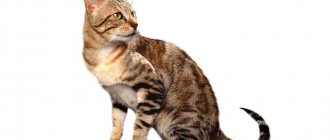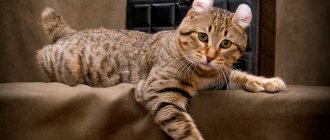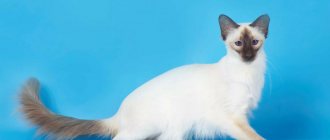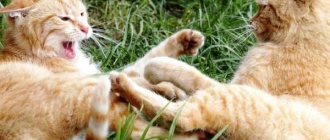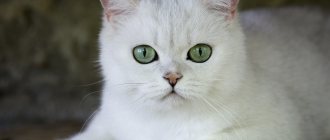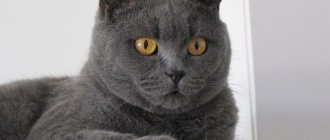The rarest cat breeds in the world are listed in the Red Book. This list includes the little-studied Caucasian forest cat, which lives in the countries of Central Asia, Eastern and Western Europe. She leads a secretive lifestyle and prefers hard-to-reach habitats.
What interesting things have experts learned about this rare breed, and what qualities attract the Caucasian forest cat? Is it possible to keep such a predator at home? You will find answers to these and other questions in our article today!
Description of the Caucasian forest cat
Caucasian cats are the largest representatives of the genus, reaching a length of 60-75 cm and having a body weight of over 5 kg. Adult cats can weigh 7-9 kg.
Brief description of the appearance of the Caucasian forest cat:
- stocky, strong body;
- a large thick tail, cut off at the tip;
- powerful paws with sharp long claws;
- large round head;
- high erect ears;
- large round eyes, color predominantly yellow-olive;
- dense coat, increasing in length in the winter season.
The color is ocher, gray, with a black stripe along the ridge and on the forehead. Dark spots may appear on the belly, and the bushy tail is decorated with several darkened rings.
The Caucasian forest cat resembles its close relatives, large predators such as the leopard and the tiger. They have identical temperaments and a well-developed hunting instinct. We invite you to see the image of a small predator living in the wild from a photo.
Brief description of the breed and distinctive features
Distinctive features of representatives of this breed: thick hair, powerful build, large size, strong bones and a pubescent, very fluffy tail. Their weight is approximately 8-10 kilograms .
These individuals have a rounded head and a short, powerful neck. The ears are set high, pointed, and if you look closely you can see the tassels. Also, representatives of this breed have thick and long mustaches. The hind legs are slightly shorter than the front legs and their muscles are well defined.
Habitats and lifestyle
Wild Caucasian cats live in different countries. They can be found in the forests of the Krasnodar region, Chechnya, Turkey, Dagestan, North Ossetia and the Caucasus mountains. Coniferous and broad-leaved forests, rocky slopes and mountain peaks are chosen for living. In rare cases, cats of this breed take root in human buildings.
Smart predators settle in rock crevices, hollows, burrows and other hidden places. Each Caucasian cat has its own area, which is personally guarded and periodically marked. This area can reach 3 km.
The festivities season begins in February-March. Cats become pregnant and bear kittens for 65-70 days. One litter produces no more than 5 individuals.
Up to 4 months, kittens live with their mother, who provides them with food and the necessary care. The growing cubs are taken on hunts and taught the necessary skills to survive in the environment.
Life at home
Caucasian forest cats raised in the wild are not the best option for keeping at home. The animal instinct and love of freedom predominate in them. Life indoors is a real test for both the animal itself and its owner.
The cat is unlikely to make friendly contact and will demand freedom with all its might. It can be aggressive, so the owner will have to exercise increased vigilance and caution when in contact with a feral animal.
If you want to have a Caucasian forest cat at home, look for such a representative in specialized nurseries where purebred kittens are bred, but more domesticated and adapted to living in enclosed spaces.
Kittens from the nursery have a more malleable character. Proper upbringing will allow you to raise a completely domestic animal with the exotic appearance of a real savage. The Caucasian forest cat is a real tiger in a smaller copy!
Caring for a wild Caucasian cat is standard. The diet is dominated exclusively by meat products, preferably fresh. This diet is common for cats from wild environments.
Wool
Long, very dense, with a superbly developed thick and slightly wavy undercoat (if you press your finger tightly to the coat, a noticeable imprint remains). The guard coat is long, close-fitting, smooth, soft and not dry, shiny, water-repellent, and covers a long, very thick and wavy undercoat, which is highly susceptible to seasonal shedding. The frill consists of three parts: a short mane, sideburns and a richly defined bib. On the hind legs there are rich wavy panties. In animals under two years of age, the frill and panties are not so well expressed. Solid, tortoiseshell and bicolor animals have softer, smoother coats than tabbies. When examining, it is necessary to take into account the time of year (and climate), since in summer the entire coat is usually shorter, and whiskers and a bib may be completely absent. Only the tail and tufts of hair in the ears and on the paws between the toes indicate that this cat is long-haired.
Belonging to the Red Book
The Caucasian forest cat is listed in the Red Book of Russia. This species of animal has a small population and is rarely found in the environment. To date, there are no special programs aimed at protecting and preserving the number of rare cat species.
Representatives of this family live in the Sochi National Park and in the reserves of the Caucasus. In the wild, they are found in remote areas. The decline in numbers occurs for various reasons. Experts suggest that the possibility of crossing wild cats with ordinary domestic cats may pose a particular threat to this genus.
A few decades ago, hunting for forest cats was opened in the Caucasus in order to obtain the animal’s fur. But today the situation has changed radically and the hunt for small predators is no longer purposeful.
Norwegian Forest cat, NFO, Semi-Longhair
WHAT ARE THEY - NORWEGIAN FORESTS?
Anyone who has seen a REAL Norwegian Forest Cat at least once will not be able to hold back a sigh of admiration and not stop to admire this gorgeous animal! And there is a lot to admire: a chic fur coat with a magnificent lion’s mane, large ears with tassels, a long, fluffy tail - you can’t take your eyes off it! A proud, regal posture, an intelligent look from slanted eyes, an ideal straight profile, a large, strong body...
CHARACTER
Despite the abundance of myths and legends associated with Norwegian forest cats, they all agree on one thing - these cats personify warmth, comfort, and friendliness.
And this is precisely the character of Norwegian Forest cats - they are incredibly gentle, love affection, are completely non-confrontational and easily get along with other animals. They are very sensitive towards children - caring nannies, and never let out their claws. Norwegian forest cats are very attached to their owners, they are ready to participate in all his affairs, accompanying him everywhere, this is a companion cat.
But don't expect them to sit on your lap for hours and run when called. Despite some similarities in character with that of a dog, in terms of loyalty, devotion, and patience, these cats are very independent, and they have their own cat affairs that they certainly need to do.
Norwegian forest cats are moderately active; they won’t run around all day long and wake you up in the middle of the night, jumping on the bed and trying to catch your leg or hand, but they won’t lie on the sofa all the time either.
Be prepared to receive a reprimand if you have been away from home for a long time in the form of demonstrative ignoring or lectures in the style of “Where have you been?”
FEATURES OF THE BREED
Norwegians are large, graceful, they can climb down from trees upside down, like a squirrel, thanks to the “lynx” proportions of their hind legs. Norwegians have a unique coat, two-layer, water-repellent, with a dense, very developed undercoat - this coat allows you to feel comfortable at any time of the year. And thanks to such fur, Norwegian Forest cats appear even larger. An adult cat weighs approximately 8-9 kilograms, a female cat is slightly smaller, but Norway reaches its maximum weight and size by 3-4 years.
CARE
Despite the luxurious fur coat, these cats require minimal care.
Many future owners are frightened by the prospect of daily combing, washing, and collecting wool around the apartment. I’ll say right away – THIS IS NOT AND WILL NOT BE!
The fur of Norwegian Forest cats is UNIQUE! It is not prone to the formation of tangles, the guard hair is dense and hard, the undercoat does not mat, and is not excessively soft. Therefore, compared to other cats with a similar coat, it requires minimal care. Norwegians need to be brushed a couple of times a week.
ABOUT US!
Cattery of Norwegian forest cats “Fashion Peak”, my name is Mikhnevich Ksenia. The cattery was registered under the WCF system in 2011, but I got my first cats much earlier. At that moment, I could not even imagine that my boundless love for this amazing breed would force me to plunge into the cat world called felinology.
My nursery presents animals from the best breed lines in Europe, the level of which has been repeatedly confirmed by victories in numerous exhibitions, shows and rings.
My animals have gorgeous, truly Norwegian wool, which I can rightfully be proud of, because at the moment, luxurious and specifically Norwegian wool is very rare!
All cats live next to us, they are sociable, sociable, have a balanced character, and get along well with children and other animals.
The nursery is located in the city of Novosibirsk, but the kittens travel to all cities of Russia and beyond. Together with you, we can choose the best route for your kitten and prepare all the necessary attributes and documents for its travel.
Only PURE BREED animals are presented in the nursery!
I will be glad to meet you, I will be glad to introduce you to this truly amazing breed of cats!
Norwegian Forest Cats are a unique combination of wild beauty and absolutely stunning, affectionate character!
Ksenia Mikhnevich, Norwegian Forest Cat Cattery “Fashion Peak”, www.fashionpeak.ru, 8-913-388-55-44.
[Show slideshow]
https://ru.wikipedia.org/wiki/Norwegian_forest_cat
Interesting Facts
Today, there are about 100 wild Caucasian forest cats. There are many legends about them, there are many historical facts.
- Difficult to train and completely unadapted to life in closed conditions, cats of Caucasian origin ended up with people and were even used as yard guards or for military purposes. These cats have a very worthy story!
- Many centuries ago, these cats were in great demand. The price for such a representative was equal to the cost of a large bull!
- Historical facts indicate the existence of the first Caucasian cats back in the time of the Duke of Wales. According to other data, domesticated cats of this species appeared 2700 years ago!
- Wild cats hiss more often, but if desired, they can produce quite decent meows.
- In just one hunt, more than 10 small rodents can be eaten. The total weight of food consumed per day often exceeds 0.5 kg.
- In winter, cats lose weight, and in summer they accumulate a lot of fat, which leads to a sharp increase in weight, approximately 2 times.
- For living they choose remote areas, primarily in the mountains at an altitude of 2500-3000 m above sea level.
- Due to the lack of small food, the Caucasian cat can hunt large game. Her catch may also include young large representatives of ungulates. It is difficult to imagine how this small predator manages to defeat such a large enemy, whose body weight and size significantly exceed the parameters of a small cat. But this fact has real confirmation!
External features
Before describing the external features of the Caucasian forest cat, it is necessary to note a surprising feature for a cat - its appearance has practically not changed since the times of mammoths and saber-toothed tigers. With climate change, the population simply became smaller and occupied the cool and comfortable region of the Caucasian mountain forests, while maintaining its original appearance.
The size of a cat ranges from 5 to 13 kilograms, sexual dimorphism is strongly pronounced and females are always smaller than males. The body length of the female is 55-63 centimeters, and the male can grow up to 90 centimeters.
A strong body meets all the requirements of the environment. But in females, the elegance of the body is achieved not only by a finer-boned skeleton, but also by thinner fur with less undercoat. Males are strong and muscular, similar to fur-bearing animals, while male cats are closer to domestic mongrel cats.
The head is medium in size with prominent cheekbones. Because of this structure, the outline of the muzzle becomes more intimidating. The eyes of the wild species are large, the iris varies from marsh yellow to green. The ears are medium, without brushes, but with an internal protective edge.
The paws, like those of most medium-sized wild cat species, vary in length; the front paws are much shorter than the hind paws, but the balance of the line is maintained due to the structure of the joints. Tufts of coarse hair grow between the toes on the pads of the paws.
The forest cat's claws are incredibly strong. In addition to hunting functions, they help the cat move along the rock without being ground down to pulp.
The tail is very long, like a leopard's, it looks dense and thick. In a healthy individual, the length of the tail is equal to the length of the body.
The coat varies greatly with the seasons. In winter, Caucasian forest cats sport a thick, stuffed fur coat of a dark shade; in summer, the cat sheds the main undercoat, and the center hair becomes lighter and shorter.
The color is most often gray; in winter it can be complemented by brown and ocher shades. There are always small uneven spots of dark fur all over the cat’s body, like a pockmarked chicken. On the tail and paws, the markings are grouped into clearer lines and half-rings.
In general, the appearance allows the species to camouflage itself very well in foliage both on trees and on the ground, where the color merges with the color of fallen leaves and tree bark.
INTERESTING: since the time of settlement of mountain peaks, the species has become accustomed to living at an altitude of 2000-3000 meters above sea level.

